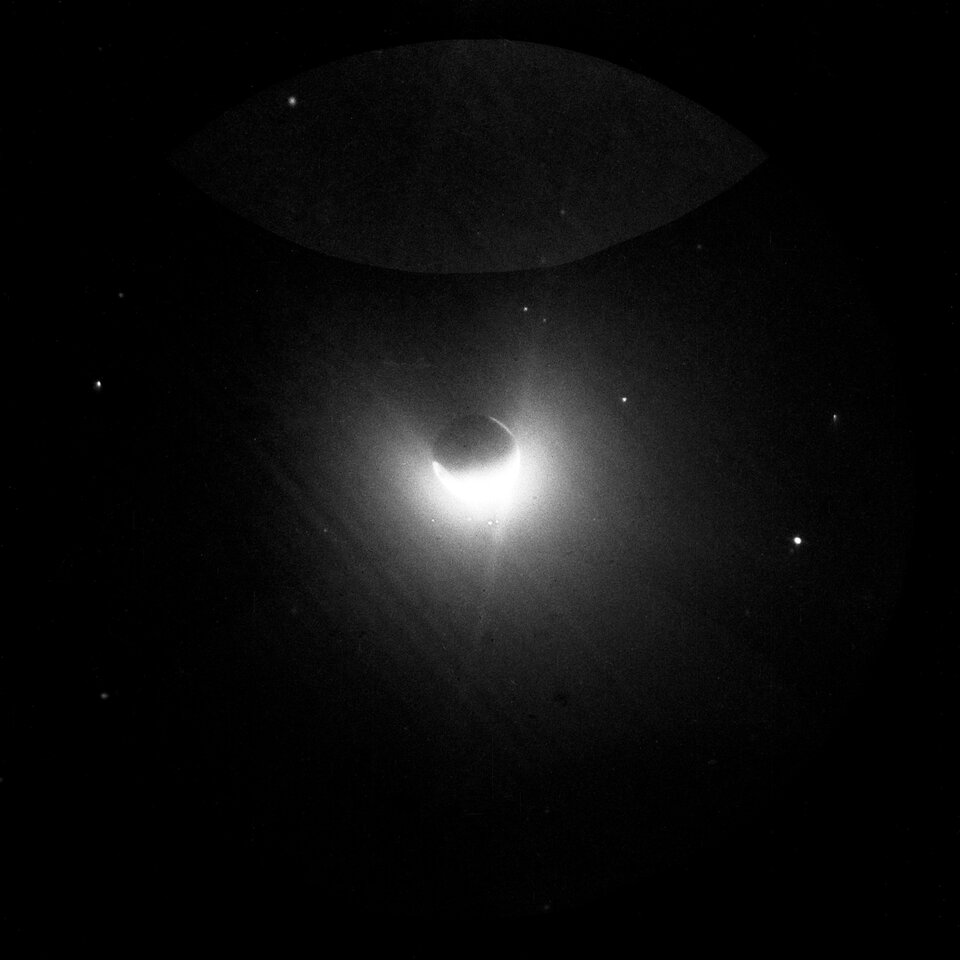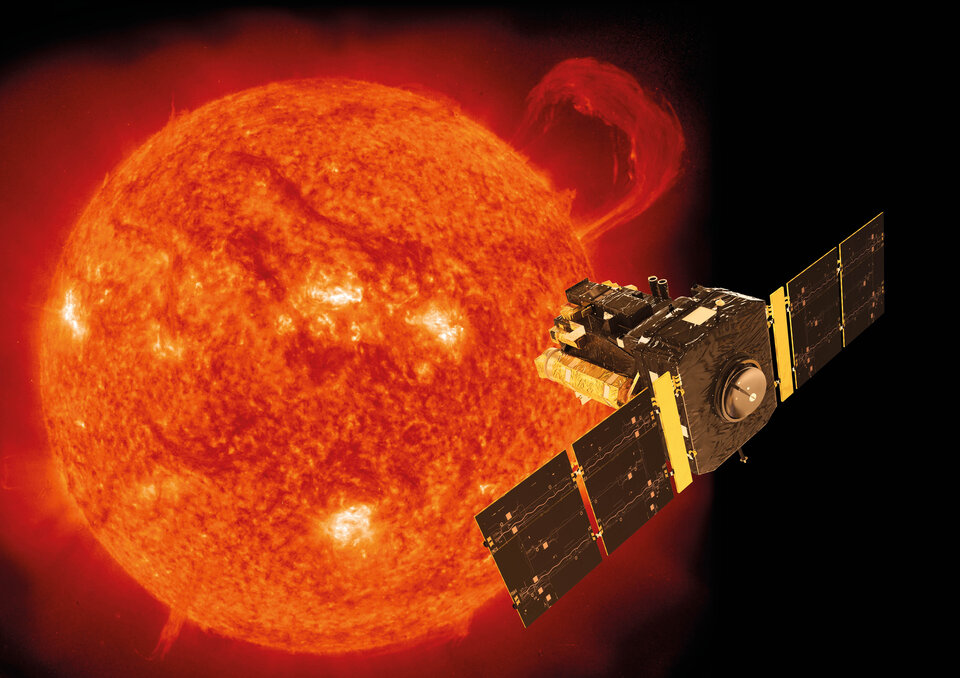Question-Which recent scientific discovery solidified the hypothesis that the 7 heavens as mentioned in the Quran is the atmosphere? by By Dr A-R Mohamed
Earth’s atmosphere stretches out to the Moon – and beyond
The outermost part of our planet’s atmosphere extends well beyond the lunar orbit – almost twice the distance to the Moon.
A recent discovery based on observations by the ESA/NASA Solar and Heliospheric Observatory, SOHO, shows that the gaseous layer that wraps around Earth reaches up to 630 000 km away, or 50 times the diameter of our planet.
“The Moon flies through Earth’s atmosphere,” says Igor Baliukin of Russia’s Space Research Institute, lead author of the paper presenting the results.
“We were not aware of it until we dusted off observations made over two decades ago by the SOHO spacecraft.”
Where our atmosphere merges into outer space, there is a cloud of hydrogen atoms called the geocorona. One of the spacecraft instruments, SWAN, used its sensitive sensors to trace the hydrogen signature and precisely detect how far the very outskirts of the geocorona are.
These observations could be done only at certain times of the year, when the Earth and its geocorona came into view for SWAN.
For planets with hydrogen in their exospheres, water vapour is often seen closer to their surface. That is the case for Earth, Mars and Venus.
“This is especially interesting when looking for planets with potential reservoirs of water beyond our Solar System,” explains Jean-Loup Bertaux, co-author and former principal investigator of SWAN.

The first telescope on the Moon, placed by Apollo 16 astronauts in 1972, captured an evocative image of the geocorona surrounding Earth and glowing brightly in ultraviolet light.
“At that time, the astronauts on the lunar surface did not know that they were actually embedded in the outskirts of the geocorona,” says Jean-Loup.
Cloud of hydrogen
The Sun interacts with hydrogen atoms through a particular wavelength of ultraviolet light called Lyman-alpha, which the atoms can both absorb and emit. Since this type of light is absorbed by Earth’s atmosphere, it can only be observed from space.
Thanks to its hydrogen absorption cell, the SWAN instrument could selectively measure the Lyman-alpha light from the geocorona and discard hydrogen atoms further out in interplanetary space.
The new study revealed that sunlight compresses hydrogen atoms in the geocorona on Earth’s dayside, and also produces a region of enhanced density on the night side. The denser dayside region of hydrogen is still rather sparse, with just 70 atoms per cubic centimeter at 60 000 kilometers above Earth’s surface, and about 0.2 atoms at the Moon’s distance.
“On Earth we would call it vacuum, so this extra source of hydrogen is not significant enough to facilitate space exploration,” says Igor.

The good news is that these particles do not pose any threat for space travelers on future crewed missions orbiting the Moon.
“There is also ultraviolet radiation associated to the geocorona, as the hydrogen atoms scatter sunlight in all directions, but the impact on astronauts in lunar orbit would be negligible compared to the main source of radiation – the Sun,” says Jean-Loup Bertaux.
On the down side, the Earth’s geocorona could interfere with future astronomical observations performed in the vicinity of the Moon.
“Space telescopes observing the sky in ultraviolet wavelengths to study the chemical composition of stars and galaxies would need to take this into account,” adds Jean-Loup.

The power of archives
Launched in December 1995, the SOHO space observatory has been studying the Sun, from its deep core to the outer corona and the solar wind, for over two decades. The satellite orbits around the first Lagrange point (L1), some 1.5 million kilometres from Earth towards the Sun.
This location is a good vantage point to observe the geocorona from outside. SOHO’s SWAN instrument imaged Earth and its extended atmosphere on three occasions between 1996 and 1998.
Jean-Loup and Igor’s research team in Russia decided to retrieve this data set from the archives for further analysis. These unique views of the whole geocorona as seen from SOHO are now shedding new light on Earth’s atmosphere.
“Data archived many years ago can often be exploited for new science,” says Bernhard Fleck, ESA SOHO project scientist. “This discovery highlights the value of data collected over 20 years ago and the exceptional performance of SOHO.”
More information
“SWAN/SOHO Lyman-alpha mapping: the Hydrogen Geocorona extends well beyond the Moon” by I. Baliukin et al is accepted in Journal of Geophysical Research: Space Physics.
For further information, please contact:
Igor Baliukin
Space Research Institute
Russian Academy of Science
Moscow, Russia
Email: igor.baliukin@gmail.com
Jean-Loup Bertaux
Former principal investigator of SWAN
Laboratoire Atmosphères, Milieux, Observations Spatiales (LATMOS)
Université de Versailles-Saint-Quentin-en-Yvelines, France
Email: jean-loup.bertaux@latmos.ipsl.fr
Bernhard Fleck
SOHO project scientist
European Space Agency
Email: bfleck@esa.nascom.nasa.gov
Markus Bauer
ESA Science Programme Communication Officer
Tel: +31 71 565 6799
Mob: +31 61 594 3 954
Email: markus.bauer@esa.int
Re: Moon is Further from the Earth than the Stars -Quran error refuted !
Some disbelievers say that God says that the moon is located in the middle of the universe based on this ayat:
 Sahih International
Sahih InternationalDo you not consider how Allah has created seven heavens in layers
 The Arabic words 'Fihaa', 'Fihinna', 'Fihim' and 'Fihi' (i.e. 'in it' or 'in them') etc. are used to imply 'within', which does not necessarily imply 'lying at the middle/center' as they want to portray.The point that would truly establish the said 'scientific' error is that the referred Arabic words for 'within' cannot be used for something that lies at the periphery of something else. In other words, what disbelievers needs to establish is that the referred Arabic words for 'within' cannot be used for the situation depicted in Square B, as shown in the diagram.So, as we can see, like many of other refuted claims, the straw man fallacy is commonly committed..
The Arabic words 'Fihaa', 'Fihinna', 'Fihim' and 'Fihi' (i.e. 'in it' or 'in them') etc. are used to imply 'within', which does not necessarily imply 'lying at the middle/center' as they want to portray.The point that would truly establish the said 'scientific' error is that the referred Arabic words for 'within' cannot be used for something that lies at the periphery of something else. In other words, what disbelievers needs to establish is that the referred Arabic words for 'within' cannot be used for the situation depicted in Square B, as shown in the diagram.So, as we can see, like many of other refuted claims, the straw man fallacy is commonly committed..
God chose the language of the Arabs as the medium for relaying His final and most important message to mankind. Among the many languages of humanity, Arabic has a very high level of subtlety and eloquence. When we study carefully the words Allah chooses to describe things, the miraculous nature of the Quran becomes quite clear.
One verse that describes the sun as a 'siraj' or lamp is:(Nuh 71:16)It is very interesting, and also one of the miracles of the Quran, that Allah uses the example of a lamp, or siraj, to describe the sun. At the time of Prophet Muhammad (peace be upon him), it was not known what exactly the sun was made of and how it produced light and heat.With the increase in scientific knowledge that Allah has blessed us with today, we now know that the sun is very much like a lamp. It requires some type of fuel to burn. When any fuel is burned and reaches a certain level of heat, the flame becomes bright enough to produce a glowing light. The sun we see every day is actually a massive ball of burning hydrogen gas that is millions of kilometers away, 149,597,892 kilometers to be exact.Allah also describes the moon using the word "muneera" meaning something that is illuminated, or lit up by something shining light on it.*{Blessed is He Who made constellations in the sky, and placed therein a Lamp and a Moon giving light.}* (Furqan 25:61)Again, this is something that has only recently been discovered, that the moon does not generate its own light, as does the sun, but rather it reflects the light coming from another source, the sun. Allah used the word "muneera" in the Quran to scientifically describe the reality of the moon's light centuries before we discovered this fact.Again, the Qur’aanicdescription matches perfectly with the true nature of the moon, which does not give off light itself and is an inert body that reflects the light of the sun.
Not once in the Qur’aan, is the moon mentioned as siraaj, wahhaaj or diya or the sun as nur or muneer.Exalted and venerated be Allah, Whose giving is plentiful, for His blessings upon His creation are evident. He is the One Who, by His grace, has adorned the lowest heaven with these great stars and planets, and the sun and the moon which give light by night and day. He has created that as part of His perfect blessings to His creation; His blessings are vast and His generosity and kindness are immense. So let them ponder the great signs that are above them, and the blessings that they enjoy, so that they might believe in their Lord and give thanks to Him.
And Allaah knows best.source :
Do you not consider how Allah has created seven heavens in layers
God chose the language of the Arabs as the medium for relaying His final and most important message to mankind. Among the many languages of humanity, Arabic has a very high level of subtlety and eloquence. When we study carefully the words Allah chooses to describe things, the miraculous nature of the Quran becomes quite clear.






Hiç yorum yok:
Yorum Gönder